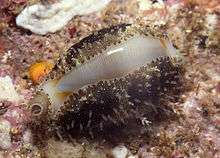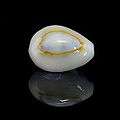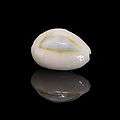Monetaria annulus
| Monetaria annulus | |
|---|---|
 | |
| A live individual of Monetaria annulus | |
 | |
| A shell of Monetaria annulus | |
| Scientific classification | |
| Kingdom: | Animalia |
| Phylum: | Mollusca |
| Class: | Gastropoda |
| (unranked): | clade Caenogastropoda clade Hypsogastropoda clade Littorinimorpha |
| Superfamily: | Cypraeoidea |
| Family: | Cypraeidae |
| Genus: | Monetaria |
| Species: | M. annulus |
| Binomial name | |
| Monetaria annulus | |
| Synonyms[1] | |
| |
Monetaria annulus, common name the ring cowrie, ring top cowrie, or gold ring cowrie, is a species of sea snail, a cowry, a marine gastropod mollusk in the family Cypraeidae, the cowries.[1]
Description
The shell size varies between 9 mm and 50 mm. The shell of this species is mostly off-white or pale yellowish in color, sometimes with a dark cast on the dorsum, and with two yellow or orange stripes along the upper sides. These stripes nearly touch at the ends, giving the impression of a ring.
Distribution
This species and its subspecies are found in the Red Sea, and in the Indian Ocean on the coasts of Aldabra, Chagos, the Comores, the East Coast of South Africa, Kenya and Tanzania, Madagascar, the Mascarene Basin, Mauritius, Mozambique, Réunion, the Seychelles, Somalia, Yemen, Oman, Maldives, India, Sri Lanka, Mozambique, in the tropical Pacific Ocean as far north as Hawaii and towards the western Pacific reaching the Galápagos islands.
Subspecies
There may be three or more subspecies:
- Monetaria annulus camelorum,
- Monetaria annulus sublitorea and
- Monetaria annulus obvelata (Rochebr.)
The subspecies obvelata is sometimes elevated to full species status as Monetaria obvelata.[2]
Use as shell money
In parts of Asia, Africa and the Middle East, Monetaria annulus, the ring cowry, so-called because of the bright orange-colored ring on the back or upper side of the shell, was commonly used as shell money much like Monetaria moneta. Occasionally the ring part on its back would be hammered away, making it nearly indistinguishable from other money cowry species. Many shells of the species were found by Sir Austen Henry Layard in his excavations at Nimrud in 1845–1851. The shell was also introduced to Native Americans during and after the fur trade by European traders as a cheaper substitute for highly treasured elk ivory,[3] for dowry, and for other uses as ornaments.
Images of shells

 Ventral view
Ventral view- Monetaria annulus with the dorsum cut off
 Monetaria annulus sublitorea may be a subspecies
Monetaria annulus sublitorea may be a subspecies Monetaria annulus obvelata may be a Tahitian subspecies
Monetaria annulus obvelata may be a Tahitian subspecies
References
- 1 2 Monetaria annulus (Linnaeus). WoRMS (2009). Monetaria annulus (Linnaeus). Accessed through the World Register of Marine Species at http://www.marinespecies.org/aphia.php?p=taxdetails&id=216875 on 10 October 2010.
- ↑ Monetaria obvelata (Lamarck, 1810). WoRMS (2011). Monetaria obvelata (Lamarck, 1810). Accessed through the World Register of Marine Species at http://www.marinespecies.org/aphia.php?p=taxdetails&id=570809 on 20 June 2018.
- ↑ http://www.turtletrack.org/Issues02/Co04202002/CO_04202002_Elkteeth_Dress.htm
- Verdcourt, B. (1954). The cowries of the East African Coast (Kenya, Tanganyika, Zanzibar and Pemba). Journal of the East Africa Natural History Society 22(4) 96: 129-144, 17 pls.
External links
| Wikimedia Commons has media related to Monetaria annulus. |